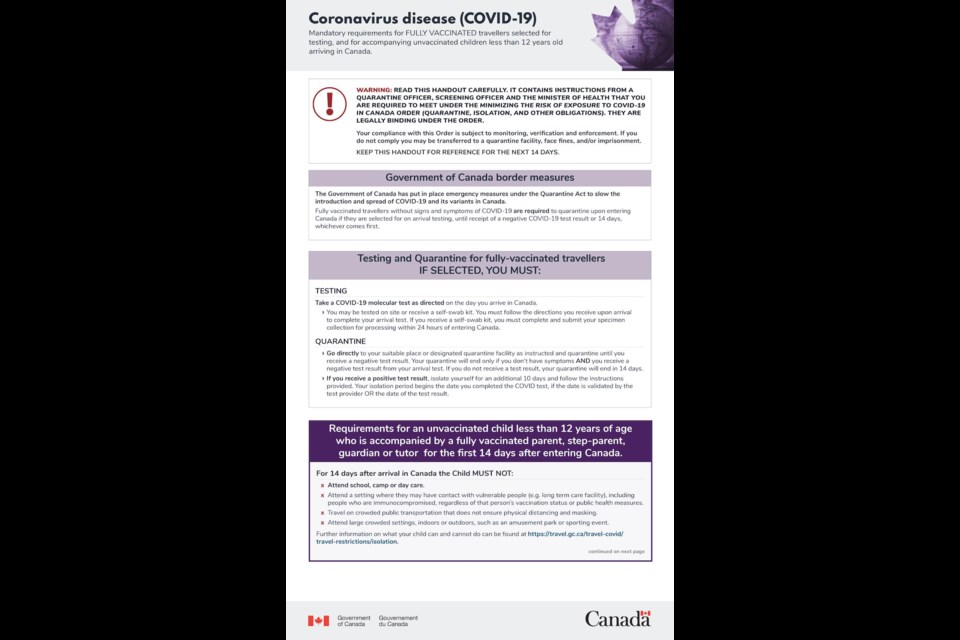If you are anxious about travelling over the holidays or in the near future, you are not alone.
While Canadians are still permitted to travel outside of the country over the holiday season, the federal government stresses that the rapid spread of the recently discovered Omicron variant poses a grave threat to public safety.
The Government of Canada now advises against until further notice and stresses that you may contract coronavirus outside of the country. Additionally, many foreign governments are implementing strict travel restrictions and international transportation options may be limited. As a result, you may have difficulty returning to Canada.
If you are confused about what kind of guidance you'll be given at the airport, the Public Health Agency has released several information sheets that explain what instructions travellers will be given when they pass through customs.
Fully vaccinated Canadians
Fully vaccinated Canadians must take a COVID-19 molecular test as directed on the day they arrive. They may be tested at the airport or given a swab test to take at home.
If you receive you receive a self-swab kit, you must complete and submit your specimen collection for processing within 24 hours of entering Canada.
If you are instructed to quarantine, you must go directly to your suitable quarantine location and stay there until you get a negative test result. You will only be allowed to leave if you don't have symptoms of the virus and received a negative test result. If you do not receive a test result, your quarantine will end in 14 days.
Requirements for an unvaccinated child less than 12 years of age who is accompanied by a fully vaccinated parent, step-parent, guardian or tutor for the first 14 days after entering Canada.
For 14 days after arrival in Canada the child must not:
- attend school, camp or daycare
- attend a setting where they may have contact with vulnerable people (e.g., long term care facility), including people who are immunocompromised, regardless of that person’s vaccination status or public health measures
- travel on crowded public transportation that does not ensure physical distancing and masking
- attend large crowded settings, indoors or outdoors, such as an amusement park or sporting event
The child must take COVID-19 molecular tests as instructed unless you have evidence that the child had a positive COVID-19 test taken 14 to 180 days prior to arrival in Canada or the child is under 5 years of age.
What if you test positive for the virus on arrival?
If you test positive for COVID-19 upon arrival to Canada you must go directly to your quarantine location. You must not use public transportation, such as a bus or a train, and you must wear a "well-constructed, well-fitting mask on the way there. You must remain in your vehicle as much as possible and avoid stops on the way there.
Once you are there, you must report your arrival at your place of isolation within 48 hours in ArriveCAN or 1-833-641-0343 (if you did not use or cannot use ArriveCAN).
You must continue to monitor for symptoms throughout your isolation period ( for a minimum of 10 days).
Actions in isolation
You should:
- Avoid all in-person interaction with others, including members of your household, if possible.
- When unable to avoid sharing a space with members of your household, everyone should wear a medical mask or a well-constructed and well-fitting non-medical mask.
- Access the necessities of life (e.g., water, food, medication and heat) without leaving isolation.
- Food, groceries or other necessities should be left at your door for contactless delivery.
- Only go outside on a private balcony or yard while respecting physical distancing from other household members.
- Use a separate bedroom and bathroom.
You should not:
- Do not use shared spaces such as lobbies, courtyards, restaurants, gyms or pools.
- Do not have any visitors.
- Do not leave your place of isolation except for an essential medical service or treatment, to obtain a COVID-19 molecular test, or as authorized by a quarantine officer.
- If you must seek medical care, do:
- wear a medical mask
- use a private vehicle, and do not take public transportation
- If you must seek medical care, do:
Find out more information with PHAC .
A note on testing at the Vancouver International Airport
Vancouver International Airport provided the following statement to Vancouver Is Awesome regarding its testing strategy.
"At this time, international travellers and those arriving from the U.S. should expect to be tested and are encouraged to register for their test in advance to help streamline the arrivals process.
"As we build capacity for arrivals testing, we are using all areas of our terminal and the journey through YVR may look different. We have relocated the international meet and greet location from Arrivals Level 2 to Departures Level 3, near the international food court. This move allows us to fill out level two with more COVID-19 testing pods."
Allow ample time to check-in at the airport, clear security and board your flight. Factor in time for traffic congestion, parking, walking to the terminal and moving through current travel measures.
Find out more travel trips with YVR .
Disclaimer: Vancouver Is Awesome does not support travel during the non-essential travel advisory. Many foreign governments are implementing strict travel restrictions due to the spread of the Omicron variant and international transportation options may be limited. As a result, you may have difficulty returning to Canada.




